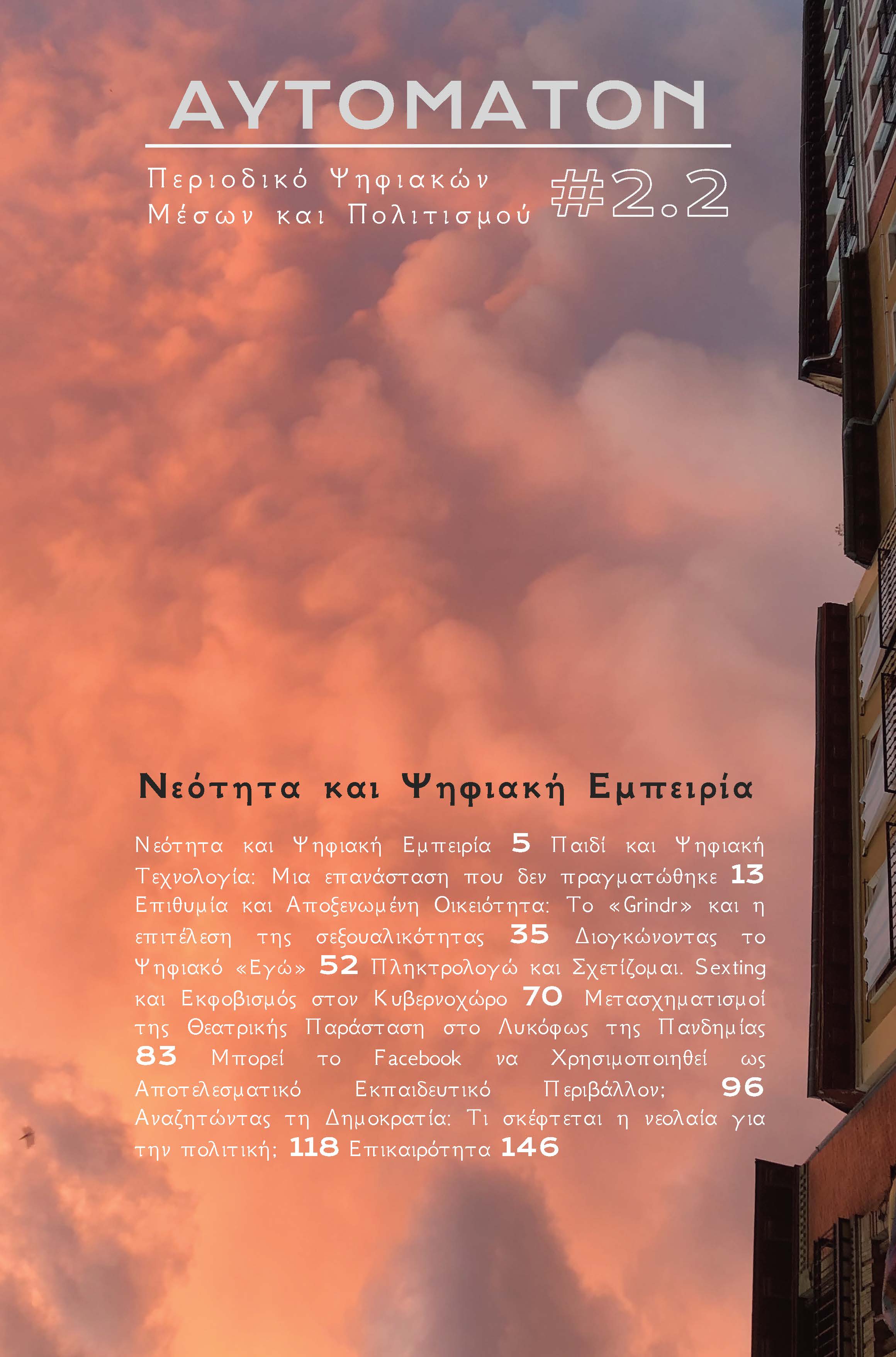Πληκτρολογώ και Σχετίζομαι Sexting και εκφοβισμός στον κυβερνοχώρο

Περίληψη
Οι προσεγγίσεις των σπουδών των μέσων συνομιλούν με την κλασική ψυχολογική έρευνα αναφορικά με τα ζητήματα των επιδράσεων και της επιρροής. Εντούτοις οι πολιτισμικές θεωρίες των μέσων ενίοτε απορρίπτουν άκριτα την ψυχολογική θεωρία και έρευνα αναφορικά με βασικά μοντέλα συσχέτισης του ατόμου με τα μέσα και την τεχνολογία. Σε μια προσπάθεια να προχωρήσουμε πέραν των συγκεκριμένων επιστημολογικών περιορισμών, που φαίνεται να μην καταφέρνουν να αποτρέψουν τη θεωρητική και εμπειρική μεροληψία αφενός αλλά και τον τεχνολογικό ντετερμινισμό αφετέρου, το παρόν άρθρο επιχειρεί μια συζήτηση για τη χρήση της τεχνολογίας από τα παιδιά και τους εφήβους, για το κοινωνικό νόημα της τεχνολογίας καθώς όμως και για τους κινδύνους που απορρέουν από την ανάγκη των νέων για την εμπειρία εντός του κυβερνοχώρου. Ο ηθικός πανικός, που διασπείρεται από τα μέσα επικοινωνίας αναφορικά με την επιβλαβή χρήση της τε-χνολογίας φαίνεται να παραμένει το ίδιο προβληματικός με την άκριτη απόρριψη της τεκμηριωμένης ψυχολογικής έρευνας.
Λαμβάνοντας υπόψιν το αυξανόμενο ενδιαφέρον της έρευνας για το θέμα των νέων και του κυβερνοχώρου, χρησιμοποιούμε ως παράδειγμα για την επιστημολογική μας συζήτηση δυο επίκαιρα ζητήματα που αφορούν αφενός την ψηφιακή κειμενική συζήτηση δύο ή περισσότερων ατόμων με στόχο τη σεξουαλική διέγερση (sexting) (Γαζή, Αρβανίτης 2020) και αφετέρου τον διαδικτυακό εκφοβισμό (cyberbullying).
Λεπτομέρειες άρθρου
- Πώς να δημιουργήσετε Αναφορές
-
Λαμπροπούλου Α., & Γαζή Α. (2023). Πληκτρολογώ και Σχετίζομαι: Sexting και εκφοβισμός στον κυβερνοχώρο. Αυτόματον: Περιοδικό Ψηφιακών Μέσων και Πολιτισμού, 2(2), 70–82. https://doi.org/10.12681/automaton.35476
- Ενότητα
- Articles

Αυτή η εργασία είναι αδειοδοτημένη υπό το CC Αναφορά Δημιουργού 4.0.
Οι Συγγραφείς που δημοσιεύουν εργασίες τους σε αυτό το περιοδικό συμφωνούν στους παρακάτω όρους:
1. Οι Συγγραφείς διατηρούν τα Πνευματικά Δικαιώματα και χορηγούν στο περιοδικό το δικαίωμα της πρώτης δημοσίευσης ενώ ταυτόχρονα τα πνευματικά δικαιώματα της εργασίας προστατεύονται σύμφωνα με την Creative Commons Attribution License που επιτρέπει σε τρίτους - αποδέκτες της άδειας να χρησιμοποιούν την εργασία όπως θέλουν με την προϋπόθεση της διατήρησης των διατυπώσεων που προβλέπονται στην άδεια σχετικά με την αναφορά στον αρχικό δημιουργό και την αρχική δημοσίευση σε αυτό το περιοδικό.
2. Οι Συγγραφείς μπορούν να συνάπτουν ξεχωριστές, και πρόσθετες συμβάσεις και συμφωνίες για την μη αποκλειστική διανομή της εργασίας όπως δημοσιεύτηκε στο περιοδικό αυτό (π.χ. κατάθεση σε ένα ακαδημαϊκό καταθετήριο ή δημοσίευση σε ένα βιβλίο), με την προϋπόθεση της αναγνώρισης και την αναφοράς της πρώτης δημοσίευσης σε αυτό το περιοδικό.
3. Το περιοδικό επιτρέπει και ενθαρρύνει τους Συγγραφείς να καταθέτουν τις εργασίες τους μέσω διαδικτύου (π.χ. σε ένα ακαδημαϊκό καταθετήριο ή στους προσωπικές τους ιστοσελίδες) πριν και μετά από τις διαδικασίες της δημοσίευσης, καθώς αυτό μπορεί να οδηγήσει σε παραγωγική ανταλλαγή ιδεών και σκέψεων καθώς επίσης και σε γρηγορότερη και μεγαλύτερη χρήση και ευρετηρίαση της δημοσιευμένης εργασίας (See The Effect of Open Access).


